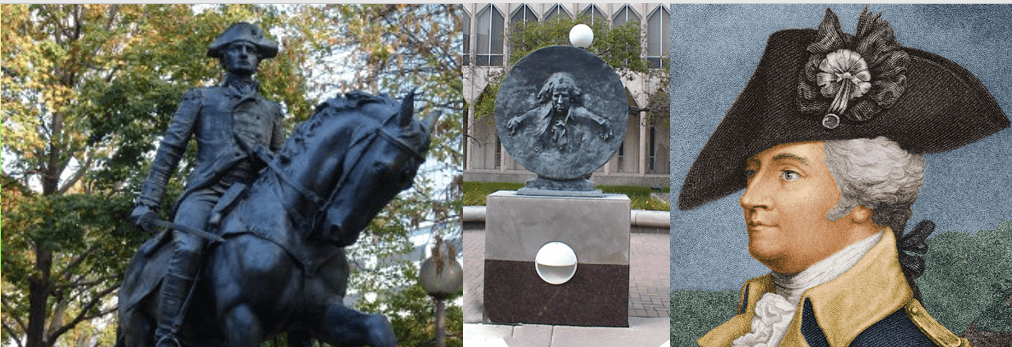This bronze cast of Revolutionary War hero, General Anthony Wayne, was created by Wayne State graduate and Italian immigrant Sergio DeGiusti in 1969. General Wayne is the namesake of Wayne State, Wayne County, and the Historic Fort Wayne on Jefferson Ave. and Detroit has good reason to honor him, as it may well have been a Canadian city without him. Numerous streets, cities, and counties throughout the Midwest and nationwide are named for Wayne. Bill Finger, the creator of the comic book hero Batman, even named Batman’s secret identity Bruce Wayne after General Wayne and Bruce Wayne is depicted as a direct descendent of Anthony Wayne in the DC comic series. Furthermore, in the comic, the land on which Wayne Manor sits is said to have been a gift from President Washington to General Wayne for his service in the Revolutionary War.
But who is this mysterious ancestor of Batman, who went by the nickname, Mad Anthony? A son of Irish immigrants himself, Wayne was an unlikely general in New England. Born in a log cabin in rural Pennsylvania on New Year’s Day 1745, he benefited from an uncle in Philadelphia who had a private academy and brought Wayne up to be a surveyor. Wayne became a prominent figure in his native Chester County, serving on the Pennsylvania legislature between 1774 and 1780. At this time met his wife Mary Penrose and they had two children together.
When the Revolution began, Wayne started out as a colonel of the 4th Pennsylvania Regiment but he quickly moved up to ranks and became a Brigadier General in 1777, but his service after the war is what he is remembered for. The American Indians, British and the new country of America had conflicting views on the purpose and ownership of the Northwest Territory or present-day Michigan, Ohio, Indiana, Illinois, Wisconsin, and part of Minnesota. The British had promised to keep Europeans east of the Appalachians, but as Americans expanded they moved into the Northwest Territory. The Northwest Territory Act of 1787 claimed the area for America, but the British refused to comply and this led to war. In 1787 President Washington charged Revolutionary War General Arthur St. Clair (who is the namesake of Lake St. Clair), but St. Clair failed to defeat the American Indians and lost hundreds of soldiers. President Washington then appointed Anthony Wayne n 1793 to take over the fight. Wayne led troops beginning in Cincinnati northward. Decisive victories in Ohio led the British to lose faith in the initiative and they began to stop backing Indian troops. The victory of the Battle of Fallen Timbers near present-day Toledo in the summer of 1794 was the deciding win. A peace treaty was signed by the Indian tribes in 1795 in Greenville, Ohio and in 1796 Wayne’s forces arrived in Detroit, where they peacefully took control from the British and claimed Detroit an American city for the first time.
Detroit had been a French territory until 1760 when the British took control during the French and Indian Wars, and the British had held control until Wayne’s arrival. Wayne lived briefly in Detroit after this victory but became ill with gout. He died due to complications from the condition as he attempted to return home to Pennsylvania in December of 1796. He was buried in present-day Erie, Pennsylvania, but in 1809 his son had his body disinterred, and the flesh boiled from his bones, so he could be transported to a family plot in Radnor, Pennsylvania. Legend has it that some of his bones spilled along the road to Radnor, present-day U. S. Route 322, and that every New Year’s Day Wayne’s spirit wanders the road in search of his bones.

Bibliography
The Appalachians [map]. (n.d.). Retrieved February 2, 2014, from geography.howstuffworks.com/united-states/the-appalachians.htm
Bob Kane [photograph]. (1939). Retrieved February 5, 2014: quietroomentertainment.com/?p=902
Candlegravity. Past [online recording]. (2010). Retrieved January 27, 2014, from freemusicarchive.org/genre/Instrumental
Christy, Howard. Signing of the Treaty of Greenville [painting]. 1795. Retrieved February 2, 2014, from wampumbear.com/W_Greenville%20Treaty%201795.html
Northwest Territory [map]. (n.d.). Retrieved February 2, 2014, from sd4history.com/unit1/nwterritory.htm
Portrait of Anthony Wayne [print]. (n.d.) Retrieved February 5, 2014: earlyamerica.com/review/fall96/anthony.html
Smith, Josh. General “Mad” Anthony Statue [photo]. (2011). Retrieved February 2, 2014, from jfade.com/?attachment_id=50
[Untitled painting of Anthony Wayne]. (n.d.). Retrieved February 2, 2014, from biography.com/people/anthony-wayne-9525637
[Untitled painting of Anthony Wayne]. (n.d.). Retrieved February 2, 2014, from sonofthesouth.net/revolutionary-war/general/anthony-wayne.htm
[Untitled painting of Anthony Wayne]. (n.d.). Retrieved February 2, 2014, from findagrave.com/cgi-bin/fg.cgi?page=gr&GRid=2711
[Untitled photograph of Wollaton Hall]. (n.d.). Retrieved February 5, 2014: gothamtrending.wordpress.com/2011/06/06/wayne-manor-locations-in-the-dark-knight-rises/the-dark -knight-rises-rumors-shooting-locations-wayne-manor-wollaton-hall-bruce-christian-bale-nolan-alfred -michael-caine-selina-kyle-anne-hathaway
[Untitled sketch of early Detroit]. (n.d.). Retrieved February 2, 2014, from passionforthepast.blogspot.com/2008/09/detroit-true-colonial-city.html
Waynesborough: Home of General Anthony and Mary Penrose Wayne [photograph]. (n.d.). Retrieved February 5, 2014: rootsweb.ancestry.com/~inmpwcd/history.htm
Zogbaum, R. T. Charge of the Dragoons at Fallen Timbers [painting]. 1895. Retrieved February 2, 2014, from ohiohistorycentral.org/w/Battle_of_Fallen_Timbers
